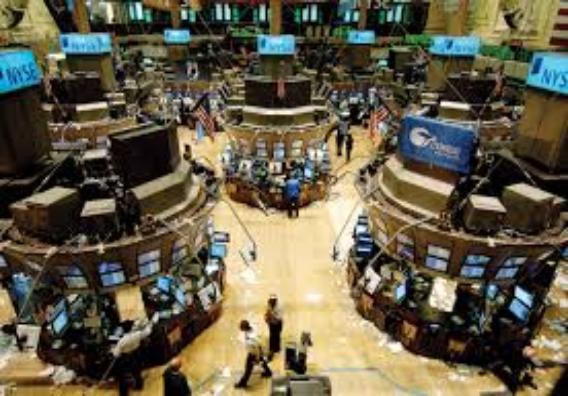
-- Start of StatCounter Code for Yahoo! Site Builder
(Windows) -->

| Real time trade alerts made in OUR VERY OWN ACCOUNTS sent to you in REAL TIME with daily updated technical charts & trading plans issued DAILY to members |
EXPLOITING THE BOLLINGER INDICATORS
April 12, 2013 6.13 AM - New York NY
RE; Utilizing bollinger bands to forecast Price fluctuations
Bollinger Bands is a technical analysis tool invented by john Bollinger in the 1980s. Having
evolved from the concept of trading bands, Bollinger Bands can be used to measure the
highness or lowness of the price relative to previous trades.
Bollinger Bands consist of:a middle band being an N-period simple moving average (MA)
an upper band at K times an N-period standard deviation above the middle band (MA + Kσ)
a lower band at K times an N-period standard deviation below the middle band (MA − Kσ)
Typical values for N and K are 20 and 2, respectively. The default choice for the average is
a simple moving average, but other types of averages can be employed as needed.
Exponential moving average are a common second choice.] Usually the same period is
used for both the middle band and the calculation of standard deviation.
Introducing Technical Analysis 101 by DayTradersGroup.com
RE; Utilizing bollinger bands to forecast Price fluctuations
Bollinger Bands is a technical analysis tool invented by john Bollinger in the 1980s. Having
evolved from the concept of trading bands, Bollinger Bands can be used to measure the
highness or lowness of the price relative to previous trades.
Bollinger Bands consist of:a middle band being an N-period simple moving average (MA)
an upper band at K times an N-period standard deviation above the middle band (MA + Kσ)
a lower band at K times an N-period standard deviation below the middle band (MA − Kσ)
Typical values for N and K are 20 and 2, respectively. The default choice for the average is
a simple moving average, but other types of averages can be employed as needed.
Exponential moving average are a common second choice.] Usually the same period is
used for both the middle band and the calculation of standard deviation.
Introducing Technical Analysis 101 by DayTradersGroup.com
The purpose of Bollinger Bands is to provide a relative definition of high and low. By definition, prices are high at the upper band and low at the lower band. This definition can aid
in rigorous pattern recognition and is useful in comparing price action to the action of Fibonacci, stochastic, RSI & ADX indicators to arrive at systematic & informed trading
decisions.
The use of Bollinger Bands varies widely among Pro traders. Some traders buy when price touches the lower Bollinger Band and exit when price touches the moving average in
the center of the bands. Other traders buy when price breaks above the upper Bollinger Band or sell when price falls below the lower Bollinger Band. Moreover, the use of
Bollinger Bands is not confined to stock traders; Options traders, most notably implied volatility traders, often sell options when Bollinger Bands are historically far apart or buy
options when the Bollinger Bands are historically close together, in both instances, expecting volatility to revert back towards the average historical volatility level for the stock.
When the bands lie close together a period of low volatility in stock price is indicated. When they are far apart a period of high volatility in price is indicated. When the bands have
only a slight slope and lie approximately parallel for an extended time the price of a stock will be found to oscillate up and down between the bands as though in a channel.
Pro Traders are often inclined to only use Bollinger Bands with numerous other indicators to verify confirmation. In particular, the use of an oscillator like Bollinger Bands will often
be coupled with a non-oscillator indicator like various chart patterns or a trend line; if these indicators confirm the recommendation of the Bollinger Bands, the trader will have
greater evidence that what the bands are fore-castjng is correct.
Bollinger Bands is a technical analysis tool invented by john Bollinger in the 1980s. Having evolved from the concept of trading bands, Bollinger Bands can be used to measure
the highness or lowness of the price relative to previous trades and also be useful in implementing static stop loss strategies
Bollinger Bands consist of:
* a middle band being an N-period simple moving average (MA)
* an upper band at K times an N-period standard deviation above the middle band (MA + Kσ)
* a lower band at K times an N-period standard deviation below the middle band (MA − Kσ)
Typical values for N and K are 20 and 2, respectively. The default choice for the average is a simple moving average, but other types of averages can be employed as needed.
Exponential moving average are a common second choice.] Usually the same period is used for both the middle band and the calculation of standard deviation.
The purpose of Bollinger Bands is to provide a relative definition of high and low. By definition, prices are high at the upper band and low at the lower band. This definition can aid
in rigorous pattern recognition and is useful in comparing price action to the action of indicators to arrive at systematic trading decisions.
The use of Bollinger Bands varies widely among traders. Some traders buy when price touches the lower Bollinger Band and exitwhen price touches the moving average in the
center of the bands. Other traders buy when price breaks above the upper Bollinger Band or sell when price falls below the lower Bollinger Band. Moreover, the use of Bollinger
Bands is not confined to stock traders; options traders, most notably implied volatility traders, often sell options when Bollinger Bands are historically far apart or buy options when
the Bollinger Bands are historically close together, in both instances, expecting volatility to revert back towards the average historical volatility level for the stock.
When the bands lie close together a period of low volatility in stock price is indicated. When they are far apart a period of high volatility in price is indicated. When the bands have
only a slight slope and lie approximately parallel for an extended time the price of a stock will be found to oscillate up and down between the bands as though in a channel.
Traders are often inclined to use Bollinger Bands with other indicators to see if there is confirmation. In particular, the use of an oscillator like Bollinger Bands will often be coupled
with a non-oscillator indicator like chart pattern or a trend-line; if these indicators confirm the recommendation of the Bollinger Bands, the trader will have greater evidence that
what the bands forecast is correct.
During the summer months the bollinger bands will range outside of historical mean reversion as it is a time when many traders losses outweigh their winnings as the months
between May thru September that have historically proven to be some of the toughest months to trade due to intense volatility coupled with low volume. Seasoned veterans,
financial analysts and some of the worlds largest hedge fund managers will employ Professional Wall Street traders to guide them through the toughest season of the year.







